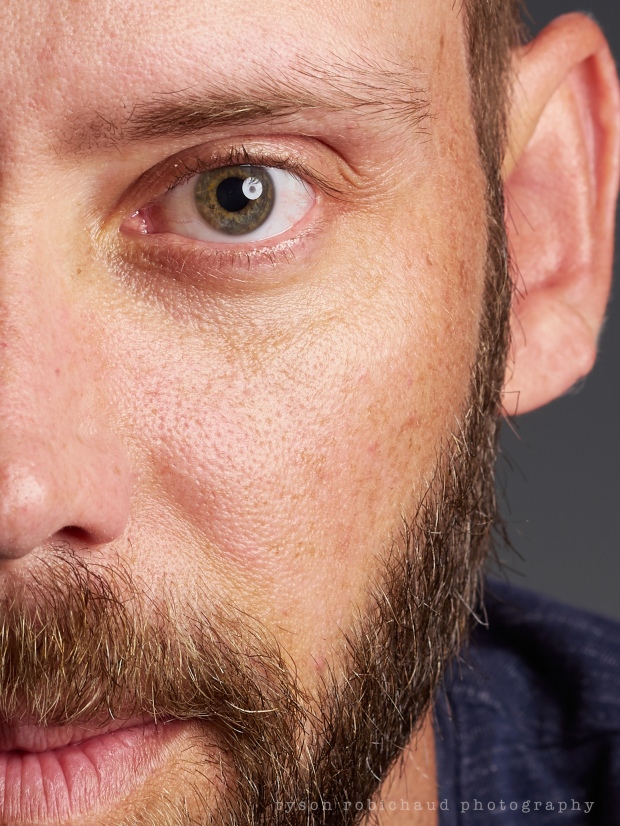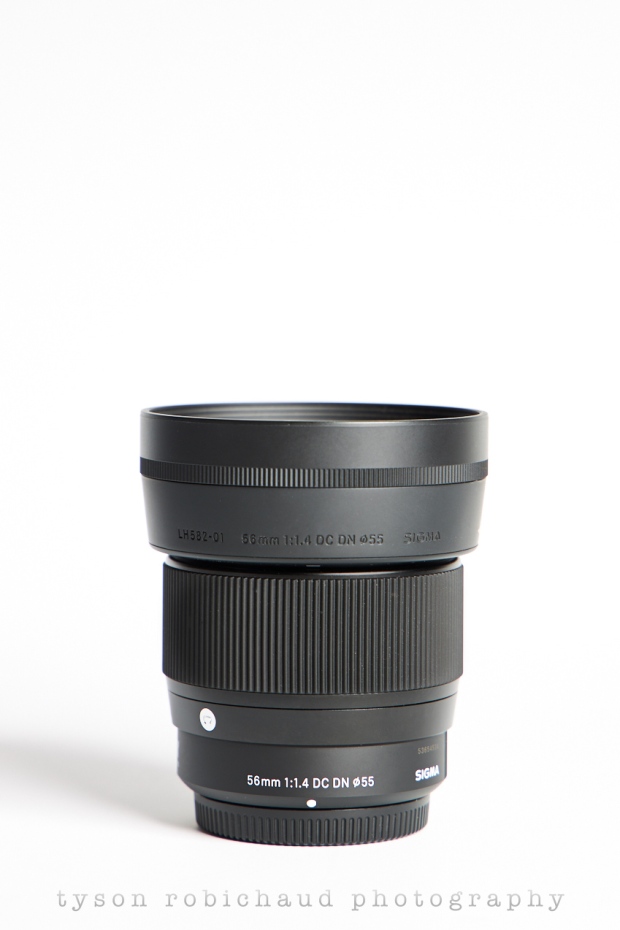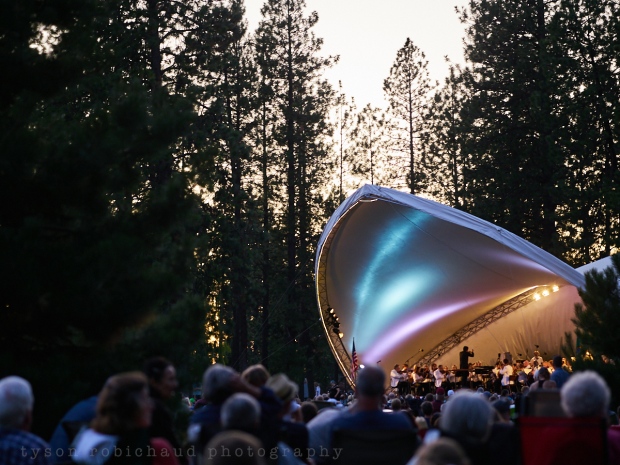
While Panasonic seemingly focuses on video featured GH cameras along with their new full frame platform, and Olympus hopes pros jump to its EM1X, I’m over here enjoying my now aged, and in my mind legendarily ‘just right’ Goldilocks GX8 with some new glass. I’ve long blown the horn for Sigma’s full frame optics, providing industry leading optical performance at honest, realistic prices (every one of the half dozen lenses I’ve tested/reviewed and/or purchased over the last few years have been wonderful), I started to wonder why I’d not tried out their crop frame offerings. Well, I have now, and I don’t know why I’m surprised, but the Sigma 56mm f/1.4 DC DN Contemporary lens is another absolute gem.
I’m using the micro 4/3 mount option, which crops to a 112mm equivalent focal length, putting it right in that mid tele, portrait sweet spot between the traditional 85mm and 135mm focal lengths. For the APS-C lot, this lens falls right into the more standard short tele ~85mm slot, which will certainly appeal to many (as it absolutely should). I for one like the extra cropping as it starts to compete with my long standing, and stellar Olympus 75mm f/1.8 lens for time on the camera when portraits or more isolated subjects, with bokehfied backgrounds come calling.
Weather sealed at the mount, compact, lightweight, fast and sharp as a tack, this lens is one I feel many system shooters can find great value in. C’mon in to see my take…
I can ramble on about this, or any lens. Simply put, I’m at a point in my photographic journey where I’m having fun. I have mostly eliminated the work side of things (largely down to geographic relocation accompanied by time allocated elsewhere on the camera strap front) and look to photography primarily for enjoyment. That I’m also a long time gear nut and reviewer couples the technical with the more artistic avenues of the craft. Because I’m not making money from photography much anymore, I’m more concerned with value, with bang for the buck if you will. Over the last handful of years, I’ve found no better way to gain said bang in the lens game, than by looking at Sigma, and the micro 4/3 system at large.
When I say bang for the buck, what I’m looking for is lens speed and optical performance at a reasonable price. I’ve talked long about how I feel the cost for many lenses in this and other systems seem greatly inflated, largely down to supporting astronomical advertising and promotional budgets by huge companies scrambling to scrape together or maintain their piece of the imaging pie. Sigma seems to have avoided a bit of that cost by resting on their newly reformed and brilliant reputation. We may not see their logos adorning photo vests at huge sporting events, or in commercials with celebrities, with the trade off being that we sport a “third party” name on the side of our lens, and possible scorn of hipster fanboys who pull from ill conceived forum comments to further bolster their egos in relation to their purchasing decisions.
Look, I too shoot and love some of the more well known “name brands” in both camera and lens, and have made my decisions for my own reasons, so I fully understand that there will be valid arguments for a particular brand’s offerings in many instances. That doesn’t mean that these third party offerings are lesser, though. We have options, and really good ones at that, for those of us willing to save a bit of money by buying into alternative manufacturers offerings. Look at what Tamron, Samyang, Voigtländer or others are providing at fractions of the cost often times. There may be tradeoffs, surely, but in various cases (as I’ve found with many of the Sigma Art lenses) they offer better optical performance and lower costs.
That said, let’s let the lens speak for itself…
Here I have the $1600 Pana-Leica 42.5mm f/1.2 Nocticron, the $480 Sigma 56mm f/1.4 and the $900 Olympus 75mm f/1.8 lenses. Three different focal lengths with varying pros and cons, certainly, but three lenses that can be used for similar subjects and effects. There are no right or wrong answers to many of the questions I pose in relation to my own curiosity, but going back to my newly refound love of value, I’d like to see what each of these lenses really provides for me and my shooting as I tend to see the Sigma as a potential replacement for both of the others.
Here is a quick and dirty portrait. All shot on the GX8 at ISO 100, 1/125 second with lenses set at f/5.6. One light camera right through a diffused beauty dish, and one light behind fired through a strip grid, all via pocket wizards. Each image was captured from the same location and distance, then cropped to match relative framing… Can you tell which is which?
1.
2.
3.
Okay, in the same order as above, here are full size crops…
1.
2.
3.
So, what do you think? There are slight differences in color rendering and contrast. Considering the Sigma and Leica lenses needed to be cropped into, and each resulting image being of a lower total resolution as a result, I’m impressed with all three myself with a little extra going to the Sigma and Leica in slightly growing amounts based on the crops. All three lenses, to my eye, are sharp AF at that f/5.6 setting. So, which was which?
.
.
.
.
.
.
.
- Leica 42.5mm
- Sigma 56mm
- Olympus 75mm
The good news, is that all three are very, very capable portrait lenses. The bad news is that one of these lenses is twice the price of the Sigma, and the other is over three times the price of the Sigma (at non-discounted, full retail anyway as the Leica is and has been $400 off of late making it more of a ‘deal’).
So, at an aperture that all three test pretty much off the charts at, they’re all remarkable in my opinion. You couldn’t go wrong shooting portraits with any of these three, under controlled and optimal conditions.
HOW ABOUT RESOLUTION WIDE OPEN? All shots below were shot with each lens wide open, and corresponding exposure values. Point of focus was the “LUMIX” on the front of the Lumix 14mm f/2.5 lens, with all lenses manually focused using MF magnification assist and Focus Peaking. Position of the camera was adjusted physically to as closely frame the scene identically and maintain identical resolution. ISO was set at the base (ISO 200) with corresponding widest apertures set, and shot on Aperture Priority which automatically adjusted the shutter speed to set the same exposure between the three shots. 2 second timer was used and of course, the GX8 was on a tripod. All full shots followed by the three side by side at 100% below. Have a looksee and click any to see larger:
Leica 42.5mm @ f/1.2
Sigma 56mm @ f/1.4
Olympus 75mm @ f/1.8
100% Crops (from left to right: Leica 42.5mm f/1.2 – Sigma 56mm f/1.4 – Olympus 75mm f/1.8)
Wide open, the Leica is obviously softer than the other two. (I took two separate manually focused shots, along with one AF frame for good measure for each lens). The Sigma however, is as sharp, if not slightly sharper than the Olympus, wide open while being 2/3 stop wider. Impressive.
While this isn’t a purely fair comparison, I did stop both the Leica and Sigma down to f/1.8 to match the Oly, A) because they can stop down, and B) because it’s the first available aperture that all three lenses can shoot at.
Stopped down to f/1.8, the Leica certainly sharpens up and gets closer to the Olympus, but look at the Sigma… Yowza. The Leica and Olympus have long been two of the sharpest lenses available for the system, and I’ve never had any problems, nor complaints on that front with either. The Sigma 56mm lens however shows what Sigma has been doing so well of late. Another big win for Sigma, and our pocket books, assuming of course the focal lengths on offer suit your needs.
MINIMUM FOCUSING DISTANCE (MFD) AND MAGNIFICATION
So, what benefits do any of these lenses have over the others outside of pure sharpness or resolution? Well, the Leica is an f/1.2 lens, which very few lenses in existence can boast, allowing faster shutter speeds in lower light. The Sigma is but a third stop slower at f/1.4 clocking in at a 13.5mm longer focal length and identical minimum focusing distance meaning it can further shallow up the depth of field at that MFD. The Olympus is a stop slower than the Leica, and 2/3 stop slower than the Sigma but has the longest focal length of the three , handy when shooting more distant subjects and wanting to maintain the highest resolution without cropping, but has a disadvantage at maximum magnification while offering up a longer MFD (see below), and is bested by the Sigma in pure sharpness when both are shot at f/1.8 (if not even wide open on part of the Sigma).
The Leica and Sigma have an identical minimum focusing distance (.5m/1.64′). The Sigma has a quite thin depth of field at 0.01 feet, that’s 1/100 of a foot or less than an eighth of an inch or under 3mm. That’s thin. The Leica, at that same minimum focusing distance at its maximum aperture of f/1.2 produces 1/200″ thicker a DOF at 0.015 feet, or 1.5/100 of a foot, also insanely thin. The Olympus at it’s max aperture of f/1.8 and it’s minimum focusing distance of 0.84m/2.76′, produces a depth of field of a whopping 0.02 feet, or 2/100 of a foot in focus which might get you either an eyelash, or an iris to be in focus. What this has meant to me, in a real life scenario, is that often times I’ll AF off of an eye, and it will catch the eyelash, and the actual eye will be out of that acceptable DOF, when shooting close in, or one eye will be in focus and the other will not be, even if squared up to the camera. All of these measurements are impractically thin working depths of field, but that doesn’t mean we shouldn’t illustrate it, right?
What does this all look like in practice? Well, have a look:
Minimum focusing distance (MFD) wide open:
Leica 42.5mm @ f/1.2

Sigma 56mm @ f/1.4

Olympus 75mm @ f/1.8

These are Lego storm troopers. Their heads measure roughly a half inch in depth from front to back. This is less depth than the distance between the tip of your nose and your eye. If you look, you can see that the backs of their helmets are already out of focus. Mayhaps you’ve heard of people grumpily bitching that their lens’ auto focus doesn’t work, or a lens has “serious back or front focus issues”, which may be the case (for DSLRs anyway), as that is a real problem. But often times, I’d wager those whining are just trying to rely on an auto focus system that gets thrown off by locking onto a hair, or the subject (or photographer *gasp*) slightly moves due to the act of breathing after the AF has locked in. Shallow DOF like this can make for a hugely challenging situation, and while fun for effect, be careful what we’re asking for with these remarkably fast lenses.
To see these three lenses, again at their minimum focusing distance (.5m/1.64′ for both the Leica and Sigma, and .84m/2.76′ for the Olympus) set to f/5.6, to see how the focal length and focusing distance differences affect the depth of field at this MFD.
Minimum focusing distance (MFD) at f/5.6:
Leica 42.5mm

Sigma 56mm

Olympus 75mm

What this shows us, is that the Sigma’s focal length, and shorter minimum focusing distance is capable of creating the shallowest DOF when shot at these three lenses respective MFD.
All of this is technobabble though. What I appreciate about the Sigma is the overall package. It’s smaller and lighter than either of the other two, being composite as opposed to metal, and is at least partially weather sealed, which neither of the other two are. It’s nearly as fast as the Leica, and faster than the Oly. While these three focal lengths aren’t remotely identical, they are able to be used interchangeably, for much of my shooting needs. As long as I’m able to be mobile by getting closer to, or further from my subject, I can use these three pretty congruously. While the Leica and Olympus are different enough to justify both in the bag, I find the Sigma a good replacement for both of these lenses.
Now, I may eventually get rid of the Leica, but an f/1.2 auto focus lens is a handy tool, no matter the system or focal length. The Oly on the other hand is proving to be surplus with this Sigma around. Other than it being a little longer, it doesn’t really offer me anything the Sigma can’t also do well enough. (I’m selling a bunch of gear HERE if you’re interested, this 75mm included, email me with any questions)
Finally, I’ll share some images that I’ve taken using this Sigma lens over the last 6 months or so. I’m obviously happy with the purchase, so much so that I’m getting rid of the 75mm, and may possibly sell off the Leica as well, in time.
f/5.6 – 1/500th – iso 200
f/2.2 – 1/800th – iso 200
f/1.4 – 1/8000th – iso 200
f/1.4 – 1/160th – iso 200
f/2.8 – 1/1000th – iso 200
f/1.4 – 1/125th – iso 1250
f/4 – 1/125th – iso 200
f/1.4 – 1/160th – iso 200
f/1.4 – 1/1600th – iso 200
f/2 – 1/5000th – iso 200
f/5.6 – 1/125th – iso 200
Thanks for the read. All gear links throughout the article are, as per normal, linked through my B&H affiliate account. You can see the Sigma 56mm f/1.4 here via B&H.
Find me via the socials and hit me up on Facebook, Twitter, Flickr and Instagram.
To stay up on new articles, you can add your email address at the top of the page (via standard browser) or below if viewing on a mobile platform.
Happy Shooting!
Tyson





















Hey Tyson…nice quick review…so just looking at the 1st 3 images…I picked the middle as my favorite which turns out to be the sigma…for me coming in 2nd is the oly 75 mm…and last is the leica…I no longer shoot micro 4./3 but that 75mm is fanatstic…one of the sharpest lenses I have ever used…sometimes…female portraits…it is too sharp…just a question now…do you ever use speedlights…I would like to see your input on the godox V1 round head speedlight…be well
LikeLike
Hey Kenn!
Thanks for the comment. All three of these lenses truly are wonderful, and honestly, this whole exercise is like splitting hairs.
Regarding the speedlights, I have long had a couple of canon EX580 II’s around which have handled everything I’ve needed (along with a couple Alien Bee 800s when needing more power). Between those 4 lights, I’ve not needed to buy anything else for nearly a decade now…? Wow. I will say, those Goxox V1’s look absolutely killer for the price though. If I were shopping for a speedlight, that would be where I started my exploration and investigation, for sure.
LikeLike
I have a Meike MK320 dedicated TTL (£60). TINY and perfect for giving much more than pop-ups, or in my case even better as my GX8 doesn’t have pop-up flash. Integrates to the GX8 with no probs. Worked great on my previous GX7. Self powered of course. Worth considering.
LikeLike
For a dedicated, on camera TTL flash, absolutely! For me, I personally don’t use the speed lights on camera as much as I use them remotely (with wireless triggers), and I think in that use, the Godox will act as a very powerful light, and for the price and mobility, it could be seen as a quick and dirty traveling studio light. Might also be a little cumbersome on a m4/3 camera though.
LikeLike
God, I forgot how ugly the lumix gx8 was lol. Another thing, the sigma is not a weather sealed Lens.that’s false advertising. There is only a seal in the back but not other seals. You’re very far from a olympus wheather sealed Lens for exemple( multiple seals). Shooting in the rain with that lens will kill the af motor in no time. Also the sigma does not have fast and precise af. It hunts a lot. Ton of thread on that..
LikeLike
Well, beauty is in the eye of the beholder I guess. Beyond outward appearance, I will say after getting used to the grip on the GX8, it is superior to every micro 4/3 “rangefinder” style camera I’ve shot with in ergonomics, and blows the OMD EM5 platform out of the water when hanging onto it with larger optics for me.
With a fixed barrel (no rotation, nor perpendicular movement outside a rotating focus ring) the need for seals is minimized. While the initial claim was ‘weatherproofed’ it is fair to say that the seal is on the mount (which still offers more sealing than either the Nocti, or Oly 75). Oly “pro” or higher end Pana lenses that are weather sealed certainly offer a higher standard of environmental sealing, but just look at the costs of those lenses. For value bang:buck, and image quality, this lens stands strongly on its own. Regardless, I’ve shot this lens in rain and while I’ve not dunked it in water, it has held up very, very well with no ill effects over the last half year or so. I appreciate bringing that up, and I’ve adjusted the article so as not to incorrectly lead us astray.
As to your claim about sigma not having fast and precise AF, I’d like you to provide personal proof of that because I shoot a lot of Sigma lenses, and they’re all quick, snappy and very accurate. Far more so than the Olympus 75, which used to struggle A TON on my OMD EM5 in anything but EV15+ full sun. AF issues are more to do with the camera’s AF system and potentially communication (which I’ve found to be far more an issue with Oly bodies than Pana bodies, personally) with these newer lenses as the AF motors in lens, are all pretty solid nowadays.
I appreciate the comment, but feel much of your criticism is not particularly founded in personal experience as it directly conflicts with mine.
Thanks man.
Cheers,
Tyson
LikeLike
Outstanding review! Thanks.
LikeLike
Thanks for the excellent review. Sigma has designed some of the best lenses in the micro four thirds (MFT) system, including the 75mm (Sigma filed for a patent on the design of the 75mm lens and for the Panasonic Leica 50-200mm f2.8-4 zoom, among others), so it is not surprising that Sigma’s offerings are so good. Sigma has a trio of f1.4 MFT lenses available: 16mm f1.4, 30mm f1.4, and 56mm f1.4.
LikeLike
Yes, and this lens definitely has me looking at both of the other DC DN f/1.4 offerings! Thanks for the read and comment.
LikeLike
Just read your review of the Sigma 56mm f1.4 DC DN Lens and concur with your findings.
I have been using the Sigma 56mm f1.4 DC DN Lens since February 2019 and I like this small, lightweight lens. I bought this lens for photographing people in low light and for subject separation in my Street Photography.
This lens on my Lumix GX80, GX8 or my Olympus OMD-10 MKII is fast and precise in focusing and other than another Sigma MFT lens I own is the sharpest lens I use.
A few of my photos, all taken at around F1.4 with the Sigma 56mm f1.4 DC DN Lens can be found here:
LikeLike
Beautiful images, and I really like the B/W treatment.
I’ve found that many who’ve complained about Sigma lenses AF “issues” either A) haven’t actually shot the lenses in question and go off of forum comments that may or may not be legit (or have often been found to be user error) and/or B) aren’t quite understanding how thin the DOF is when shooting at these working distances (portraiture, et al) at fast apertures combined with their camera’s AF settings. If you shoot single shot AF, or focus/recompose, or your subject breathes, or you breathe, that razor thin DOF can very easily be thrown off between the time the camera/lens focus and the shutter is engaged. I’ve had these “problems” with manual focus lenses too 🙂
I’ve not had any issues shooting recent Sigma lenses on three different platforms (Canon EOS DSLR full frame, Sony FE mirrorless and Micro 4/3) both natively and adapted. They’re snappy, accurate and remarkably sharp. Now, that’s not to say that there aren’t legitimate issues here or there, but one thing I’ve appreciated is most Art (or at least the DG) lenses from Sigma include a USB dock to micro adjust the lens, or update the lens’ firmware, which can eliminate most any issue, or future issue one comes across. I think Sigma has done the whole lens game correctly. Offering a lot at very competitive pricing.
Thanks for the read, Robert!
Happy shooting,
t
LikeLike
Thank you, your photos are great.
LikeLike
My pleasure, thank you!
LikeLike
I read your review of the 56mm f1.4 and have seen many very positive reviews and have been seriously considering it but I have the Oly 60mm f2.8 that I sort of used as a general multi purpose lens. Then I checked your review on the 60mm macro and realized that it was exactly how I’ve been feeling about it. Though I didn’t really get into too much macro, I too was disappointed as a multi purpose lens with the hunting and no hard stops for manual focus. I just want decent close focus and I think the 56mm is enough and also a good portrait/multi-use short tele lens… (also considering Panasonic 42.5 f1.7 though) .
I used to own the first Sigma 30mm f2.8 (sharp but odd length for m43)
thanks
LikeLike
Thanks for the read and comment, Norm! One thing we m4/3 users have had to get used to, is “odd” focal lengths, traditionally speaking anyway. Most third party compatible lenses are re-tooled APS-C lenses, and even in the case of proprietary lenses (Oly 60, 75, Pana 15, etc) we have some odd ducks. That all said, it really just causes us to adapt to a given angle of view, which is easier as the focal length gets longer in my opinion. Personally, when looking at the Sigma 56/1.4 vs the Oly 60/2.8, there is no comparison. The Sigma is sharper (I assume based on it besting the Oly75 which is still one of the sharpest system lenses), snappier and two full stops faster. No it’s not a macro lens, but I never found the Oly to perform well enough as one to be useful in any real way, myself, so… if portraiture and general use is the end game, the Sigma will take you much further from a performance, overall quality and versatility angle, I’d wager. It certainly has for me!
Cheers,
Tyson
LikeLike
Nice write up (as always)
LikeLike
Thank you sir!
LikeLike
A superb and very useful review, the kind on which folk can make reasoned and intelligent decisions. I have lenses all around this one, Oly 45 1.8, Oly 60 2.8 and Oly 75 1.8. At least two can go once this is acquired so it practically pays for itself. Thank you. I look forward to further reviews.
LikeLike
Thanks Bob! That’s really how I saw this lens for myself as well. Months along and it has further justified that decision to me.
Enjoy!
T
LikeLike
Thanks Bob!
LikeLike
Tyson, great review! I have the GX8 and the closest I have is the Pana-Leica 45mm 2.8 which can be used as a macro or regular lens. Since the focal range is close to the 56mm Sigma, I was wondering if you could share your thoughts about these two lenses, and whether it would seem superfluous to add the 56mm Sigma to my lens collection. Thanks!
Rob
LikeLike
Hey Rob, thanks!
I’m shooting with the 42.5/1.2 still myself which is a different tool in its own right, but much closer to the 56/1.4 in pure speed and skill set.
I think the 56mm would provide you with a better natural light portrait lens, and just a better short tele low light lens in general being two full stops faster, but the 45/2.8 macro provides the macro capability, which the Sigma will not.
I think, if you wanted to save money, and don’t shoot in lower light very often, you could probably skip the Sigma, or, if you don’t utilize the macro side of things, you could sell the 45 and buy the Sigma. If not absolutely needing to save the money, I can certainly see justifying both of these lenses in one’s quiver, so I may not be the best to ask 😉
If one or the other, I’d ask yourself to judge based on macro vs two extra stops of light gathering, ultimately. Which you’d find more useful is certainly down to the type of shooting you do more often.
Hope this helps!
Best,
Tyson
LikeLike
Hello, great write-up. Highly considering this lens for my GX9 as my main and only “portrait” lens. Separate question though: what brand of camera strap is pictured here? That seems to be exactly what I am looking for.
LikeLike
Haha! I think I just answered my own question. Found the “camera straps” link in the main menu. Checking them out now.
LikeLike
Hi Mike!
Thanks for the read. The Sigma 56 has continued to be amazing for me. I have it on one of my m4/3 cameras all the time. It has been wonderfully versatile and does an amazing job for portraiture especially.
Regarding the straps, the one on the GX8 is the Regatta strap, and the one on the GM5 is a modified Vector strap, both of which I make and can be found at nautistraps.com
Let me know if I can help with anything and thanks again.
Best,
Tyson
LikeLike
Hi, great review. I noticed in one of your replies that you commented that you’ve never had much luck with the Olympus 60 mm f2.8 macro lens. That comment did surprise me I must admit. I’ve never tried using it as a general-purpose lens but I actually bought into the micro four thirds system specifically for its macro capabilities with a secondhand a OLYMPUS EM1 and the 60 mm macro lens and have found it to be absolutely superb both in terms of image quality and surefootedness in focusing. I’ve never used any other system which focuses as well at macro distances as the 60mm macro lens on the EM1. So I do wonder whether whatever shortcomings you found with it, possibly in focusing, might be due to the body rather than the lens
LikeLike
Hi Phil!
It is certainly a possibility that the EM5 was the main culprit, but unfortunately, the AF I’ve seen haven’t been solely restricted to the 60mm macro. It could be that the true hybrid AF on the EM1 series helps a lot whereby the pure CDAF on the EM5 just sucked by comparison. For macro work, I also abhorred the focus by wire + default distance reset between shots on the 60mm which drove me absolutely batty. I’ve been shooting for years with a couple adapted macro lenses (canon 100mmL and an old manual focus FD 100mm f/4, both of which are a pleasure to use by comparison). I’ve also had (and continue to have) auto focusing issues with Oly lenses (namely the 75/1.8 and had with the 60/2.8 and 45/1.8 a bit) which seem to just struggle to communicate in any consistent way which has led me to limit my purchases of Oly’s optics. I did enjoy the 40-150/2.8 with little issue, and still enjoy the 7-14/2.8 that is so wide, AF isn’t really challenged in most cases. When they hit, they’re amazing but I have just not been happy with their AF performance overall, especially for the price on many of them.
This Sigma however has been bonkers. It hasn’t left one of the cameras for months!
Thanks for the read and comment, I hope you’re well and getting to shoot.
Cheers,
Tyson
LikeLike
Hi Tyson, thanks for your reply. Isn’t that interesting that your experience is so different to mine. Maybe it is the PDAF that makes the difference. Although I thought that only got used in continuous auto focus, which I never use for macro. I do know what you mean about the manual focusing though, that is painful, you seem to have to turn the focus ring forever to make much difference! To be fair though I’ve found the macro auto focus to be so good I’ve not often needed to use manual focus. I bought the E-M1 because of the in body focus stacking which works amazingly well for macro, I’ve often used it hand held with no problem.
I’ve never owned the 75/1.8 or the 45/1.8 so I can’t comment on those but the 12-40/2.8 and the 40-150/2.8 are both cracking lenses with excellent, reliable focusing on the EM1.
The Sigma 56/1.4 is definitely on my shopping list though after having read your review.
Thanks,
Phil
LikeLike
Hi Tyson, I’m very late to the party but I wanted if possible some advice… First of all thanks for the amazing review, it is crystal clear as everything else on your website! Second of all, I’m considering this lens to replace my Olympus 60mm f/2.8, which I know you’re not fond of. I’ve been happy about it so far, but my macro use has been somewhat limited, and I ultimately uses it more for close-up portraits, face or hand details (while people are chatting for instance) and architectural details (I’m an urbanist). Your close-up shot with the Sigma seems comforting, but I was wondering whether you gave a shot to the lens with something like a Raynox 250 or extension tubes, and you had any feedback on that. I wouldn’t want to lose macro capability as a while. Alternatively, I thought of adapting an Olympus OM 50/1.4 or a Pentax-A 50/1.4, paired with a 2x macro converter by Vivitar… I read good stuff online about these combinations, and manual focus wouldn’t be an issue, but I value to travel light and tend to shoot less with cumbersome equipment. Not to mention sharpness would be probably not even comparable and I’d be better off just cropping the images from the Sigma. Any input is appreciated, thanks in advance!
LikeLike
Thanks for the comments and thoughts, Giorgio. You’re right that I’m not a fan of the Oly macro, but I know a lot of people are, so one opinion should not determine its usefulness for anyone else. That said, I have not used extension tubes with the Sigma, mostly because I don’t own any for the m4/3 mount. That combined with the decent magnification and close focusing distance do well enough for me, but if I need actual macro magnifications, I do have other macro lenses to use if needed.
What I can say about the Sigma in direct comparison to the Oly 60mm, is that it’s two full stops faster, and while I don’t have the macro to directly compare, the Sigma is easily the sharpest lens I’ve seen for the system yet so it would do favorably up against any lens. It’s very quick to focus for me on the gx8 and gm5, and I really like it.
LikeLike
Hi Tyson, terrific review of the three lessons. The Sigma 56mm has been my primary lens for portraits and is hard to fault. Would agree with others that AF is ever so slightly behind Oly native lenses but that’s splitting hairs. The Sigma is a great buy for any Micro 4/3 user who want to do outdoor portraits.
My question for you is how much do the varying focal lengths of each of the 3 lenses effect compression, particularly for full length outdoor portraits? Is the difference enough to warrant the additional purchase of the 75mm or the 42mm or is it really just a matter of what focal length you want to work with?
LikeLike
Hi Steven,
Thanks for the read and comment. Let me do my best to try and answer this assuming I understand your inquiry about compression. Firstly, let’s assume we’re shooting both lenses wide open for the shallowest DOF that they’d be capable of. For the Sigma, at 56mm and wide open at f/1.4, for a full body portrait (say someone who is 5’8″ or so) they’d need to be roughly 24 feet away from the camera to get their full height in frame, in landscape orientation. This would produce a working DOF of about 2 1/4 feet. For the 75mm wide open at f/1.8, to get the same model in frame, they’d need to be about 32 feet away from the camera, which would produce a working DOF of just under 3′. For this example, the 56mm at f/1.4 would produce a shallower DOF, with quicker falloff of the circle of confusion than the 75mm would. Now, regarding “Compression” the angle of view would be the main variable with the 56mm wider than the 75, obviously. From the same location, focused to the same exact distance, the “compression” should be the same. Where you would see a difference, is in a variance in focusing distance. With a closer focusing distance, and subsequent shallower DOF, the 56mm should, mathematically, show a more “compressed” scene in relation to the subject due to these factors as I understand my math, but that can easily be greatly altered if you took 10 steps toward or away from the subject relative to the other combo, but of course, this would change the amount of scene, alter the focusing distance, and adjust the portion of the subject you captured in the frame.
Does this help?
Cheers,
T
LikeLike
Great review, just ordered mine… Will be using it on GX9 initially. Guess that will make my other stunning Sigma 60mm 2.8 redundant.
LikeLike
It might be hard to keep both around, and nothing against the 60mm as it is a damn fine lens, the extra two stops and performance from the 56mm wide open, is just too good.
LikeLike